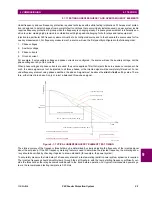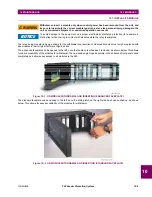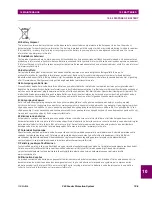
GE Multilin
F60 Feeder Protection System
8-3
8 THEORY OF OPERATION
8.1 HIGH-IMPEDANCE (HI-Z) FAULT DETECTION
8
8.1.7 LOAD ANALYSIS ALGORITHM
The purpose of the Load Analysis algorithm is to differentiate between arcing downed conductors and arcing intact conduc-
tors by looking for a precipitous loss of load and/or an overcurrent disturbance at the beginning of an arcing episode. The
presence of arcing on the system is determined based on the output of the Expert Arc Detector algorithm. If the Hi-Z ele-
ment finds persistent arcing on the power system, the Load Analysis algorithm then considers the type of incident that initi-
ated the arcing and classifies the arcing conductor as either downed or intact. Another function of the algorithm is to provide
coordination between the Hi-Z element and the power system's conventional overcurrent protection by observing a timeout,
via the
HI-Z OC PROTECTION COORD TIMEOUT
setting from the beginning of the arcing before giving an indication of arcing.
If the Load Analysis algorithm determines that a downed conductor or arcing exists, it attempts to determine the phase on
which the high impedance fault condition exists. It does this in a hierarchical manner. First, if a significant loss of load trig-
gered the Load Analysis algorithm, and if there was a significant loss on only one phase, that phase is identified. If there
was not a single phase loss of load, and if an overcurrent condition on only one phase triggered the algorithm, that phase is
identified. If both of these tests fail to identify the phase, the phase with a significantly higher confidence level (e.g. higher
than the other two phases by at least 25%) is identified. Finally, if none of these tests provides phase identification, the
result of the Arc Burst Pattern Analysis algorithm is checked. If that test fails, the phase is not identified.
8.1.8 LOAD EXTRACTION ALGORITHM
The Load Extraction Algorithm attempts to find a quiescent period during an arcing fault so that it can determine the back-
ground load current level in the neutral current. If it is successful in doing so, it then removes the load component from the
total measured current, resulting in a signal which consists only of the fault component of the neutral current. This informa-
tion is then provided as input to the Arc Burst Pattern Analysis Algorithm.
8.1.9 ARC BURST PATTERN ANALYSIS ALGORITHM
The Arc Burst Pattern Analysis algorithm attempts to provide faulted phase identification information based on a correlation
between the fault component of the measured neutral current and the phase voltages. The phase identified will be the one
whose phase voltage peak lines up with the neutral current burst. The fault component is received from the Load Extraction
algorithm. The result of the analysis is checked by the Load Analysis algorithm if its other phase identification methods
prove unsuccessful.
8.1.10 ARCING SUSPECTED ALGORITHM
The purpose of the Arcing Suspected Algorithm is to detect multiple, sporadic arcing events. If taken individually, such
events are not sufficient to warrant an arcing alarm. When taken cumulatively, however, these events do warrant an alarm
to system operators so that the cause of the recurrent arcing can be investigated.
8.1.11 OVERCURRENT DISTURBANCE MONITORING
This function is part of High Impedance Fault Detection and should not be confused with conventional overcurrent protec-
tion. The Hi-Z element monitors for an overcurrent condition on the feeder by establishing overcurrent thresholds for the
phases and for the neutral and then checking for a single two-cycle RMS current that exceeds those thresholds. Oscillogra-
phy and fault data are captured if it is determined that an overcurrent condition exists.
8.1.12 HI-Z EVEN HARMONIC RESTRAINT ALGORITHM
Every two-cycle interval the algorithm evaluates the even harmonic content of each phase current. The even harmonic con-
tent is evaluated as a percentage of the phase RMS current. If for any phase the percentage is greater than the
HI-Z EVEN
HARMONIC RESTRAINT
setting, the algorithm will inhibit setting of the overcurrent flags. This is to prevent a cold-load pickup
event from starting the Hi-Z logic sequence (which requires the overcurrent flag or the loss-of-load flag to be set at the
beginning of an arcing event). The duration over which the algorithm inhibits the setting of the overcurrent flag(s) is from the
time the even-harmonic level (as a percentage of RMS) increases above the threshold until one second after it falls back
below the threshold.
Summary of Contents for F60
Page 10: ...x F60 Feeder Protection System GE Multilin TABLE OF CONTENTS ...
Page 30: ...1 20 F60 Feeder Protection System GE Multilin 1 5 USING THE RELAY 1 GETTING STARTED 1 ...
Page 138: ...4 28 F60 Feeder Protection System GE Multilin 4 2 FACEPLATE INTERFACE 4 HUMAN INTERFACES 4 ...
Page 454: ...5 316 F60 Feeder Protection System GE Multilin 5 10 TESTING 5 SETTINGS 5 ...
Page 500: ...7 14 F60 Feeder Protection System GE Multilin 7 1 COMMANDS 7 COMMANDS AND TARGETS 7 ...
Page 508: ...8 8 F60 Feeder Protection System GE Multilin 8 2 FAULT LOCATOR 8 THEORY OF OPERATION 8 ...
Page 522: ...10 12 F60 Feeder Protection System GE Multilin 10 6 DISPOSAL 10 MAINTENANCE 10 ...
Page 660: ...B 116 F60 Feeder Protection System GE Multilin B 4 MEMORY MAPPING APPENDIX B B ...
Page 706: ...E 10 F60 Feeder Protection System GE Multilin E 1 IEC 60870 5 104 APPENDIX E E ...
Page 718: ...F 12 F60 Feeder Protection System GE Multilin F 2 DNP POINT LISTS APPENDIX F F ...
Page 728: ...H 8 F60 Feeder Protection System GE Multilin H 2 ABBREVIATIONS APPENDIX H H Z Impedance Zone ...
Page 730: ...H 10 F60 Feeder Protection System GE Multilin H 3 WARRANTY APPENDIX H H ...
















































